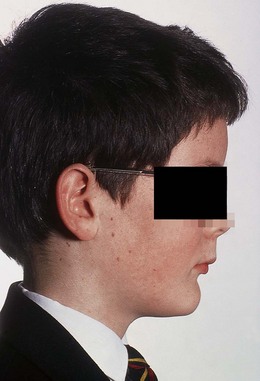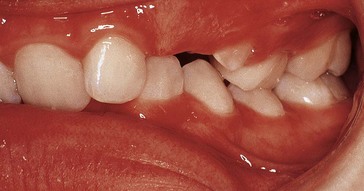12 Increased overbite
Summary
Harry, aged 10 years and 6 months, presents with crowded upper teeth and a deep traumatic overbite (Fig. 12.1). What has caused these problems and how may they be treated?
Examination
Intraoral
 The appearance of the mouth is shown in Figures 12.1 and 12.3. What do you see?
The appearance of the mouth is shown in Figures 12.1 and 12.3. What do you see?
 What are the possible causes of the traumatic overbite?
What are the possible causes of the traumatic overbite?
In a Class II division 2 malocclusion several factors contribute to an increased overbite. These are listed in Table 12.1.
Table 12.1 Causes of increased and traumatic overbite in Class II division 2 malocclusion
| Cause | Aetiology |
|---|---|
| Skeletal: anteroposterior and vertical | A Class II skeletal pattern in combination with a reduced lower facial height |
| Growth pattern | An anterior mandibular growth rotation tends to increase overbite |
| Soft tissues | Effects are via the skeletal pattern – reduced lower facial height leads to a high lower lip line that will retrocline the upper incisors, leading to overbite increase |
| A hyperactive high lower lip in association with a reduced lower facial height leads to bimaxillary retroclination | |
| Dental factors | Absence of a well-defined cingulum stop on the upper incisors leads to continued eruption of the lower incisors, increasing overbite |
 What further investigations would you undertake?
What further investigations would you undertake?
1 Assessment of the extent of soft tissue trauma palatal to the upper incisors and labial to the lower incisors from the increased overbite. Periodontal pocket depth should be probed in these areas and gingival recession should be noted. Incisor mobility should also be assessed. Although there was evidence of tooth impingement on the gingivae palatal to  and labial to
and labial to  , periodontal probing depths did not exceed 2 mm and there was no incisor mobility or gingival recession.
, periodontal probing depths did not exceed 2 mm and there was no incisor mobility or gingival recession.
 and labial to
and labial to  , periodontal probing depths did not exceed 2 mm and there was no incisor mobility or gingival recession.
, periodontal probing depths did not exceed 2 mm and there was no incisor mobility or gingival recession.2 Assessment of tooth surface wear on the upper and lower incisors – this may be on the labial aspect of the lower and/or the palatal aspect of the upper incisors as well as the incisal edges. Harry should be asked about any bruxing habit and his mother should be asked if she is aware of him having any nocturnal bruxing habit. If wear of the incisors is observed, site and extent should be noted for future monitoring; as this is better undertaken from dental casts, imp/>
Stay updated, free dental videos. Join our Telegram channel

VIDEdental - Online dental courses





 are erupted but covered by the upper incisors).
are erupted but covered by the upper incisors).

